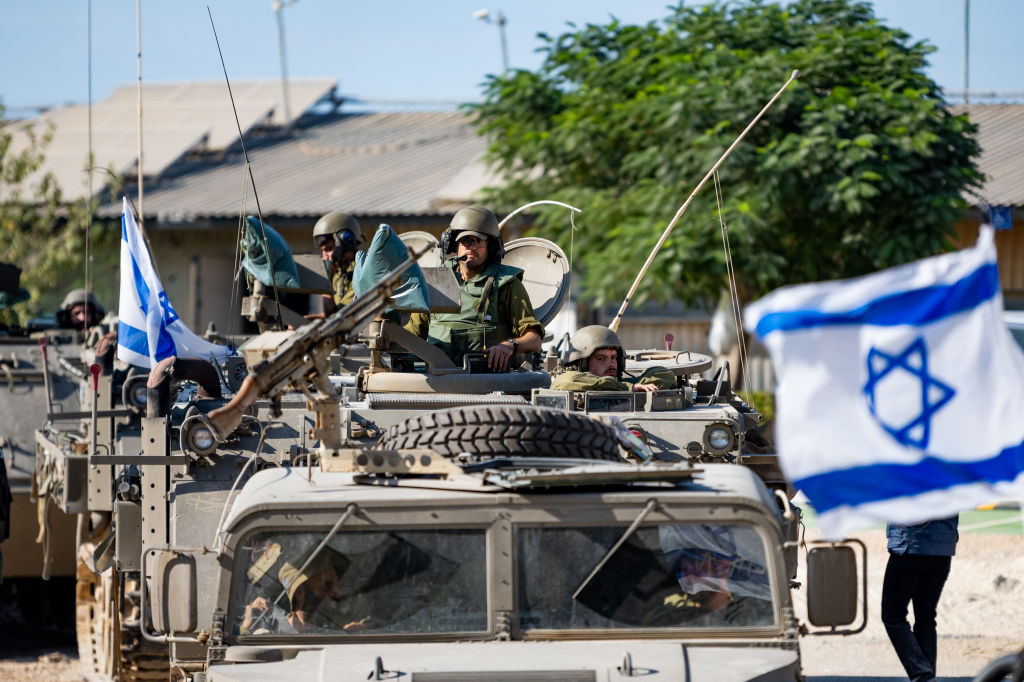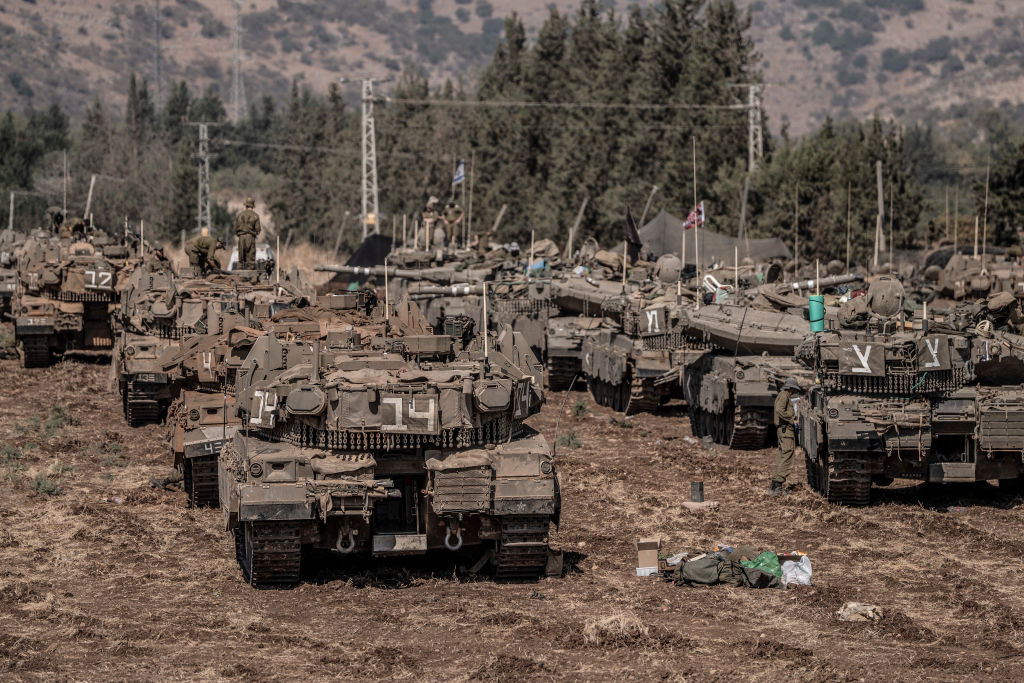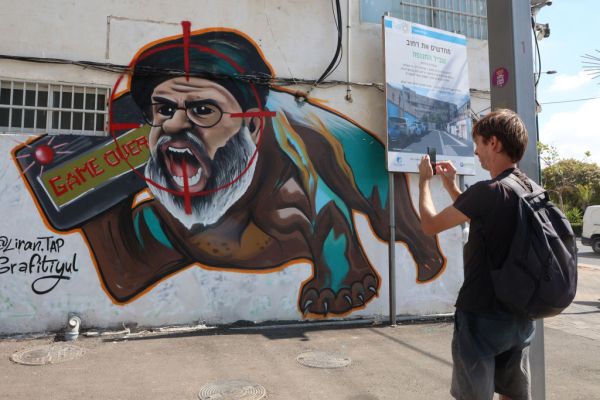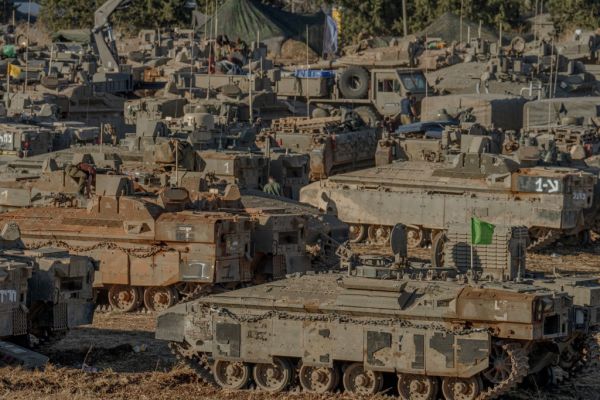When Hassan Nasrallah ordered his Hezbollah minions to begin firing rockets at Israel—just a day after October 7, 2023, when the Jewish state suffered devastation from Hamas’ barbaric terrorist attack—he likely did not imagine what a strategic error he was making. A year later, Nasrallah is dead and Hezbollah is essentially decimated, with its rocket arsenal quickly depleting under a relentless Israeli assault. There’s no sign that Hezbollah has the capacity to stop the beating, or that it will get much more military help from Iran.
Nasrallah misunderstood the military balance in play this time last year. He assumed that new developments in weapons technology, coupled with geostrategic shifts, would enable Hezbollah and the other members of Iran’s Axis of Resistance to pummel Israel at an acceptable cost to themselves and an unacceptable cost to Jerusalem. But so far, the results of the newest Middle East war have demonstrated the opposite.
Any military lessons gleaned from a year of war in the region so far can only be conditional. Yet there have been important lessons nonetheless. They speak to the true military balance in the region, at least for the moment, as well as what Israel can do—and what its adversaries would have to do—to prevail.
Israel triumphed in Gaza.
A year into the conflict, Israel appears to have crippled Hamas militarily and to have done so at a very low cost in Israeli casualties. That’s important because Hamas undoubtedly assumed, along with many outside observers, that the Israel Defense Forces (IDF) would not be able to do so. Like Nasrallah, whatever the Hamas leadership’s calculations of the damage it would take from launching the 10/7 attack, what the subsequent war has taken—roughly 17,000 of its fighters slaughtered, its formations rendered combat ineffective, many of its senior leaders killed, its control of Gaza temporarily eliminated, and only 350 Israeli soldiers killed—was clearly beyond their expectations.
Messianic though its rhetoric has been, Hamas has always sought to preserve both its leadership and its combat power. It unquestionably believed that its extensive tunnel network, defensive fortifications, and reliance on civilians as human shields would blunt an Israeli offensive, inflict heavy casualties on the IDF, and prevent Israel from doing extensive damage to the organization. The fact that this expectation proved badly mistaken is a critical outcome. It is another warning for Hezbollah, which no doubt believed that its own similar defenses would deter an Israeli ground attack that now seems imminent.
Whether Israel can turn its tactical victory in Gaza into a strategic one will be determined by the political settlement that follows—one for which Israel still does not have any workable plan. Nevertheless, the military feat is still important in its own right. Hamas got far more than it bargained for. It is not going to be in any position to try something like 10/7 for years. Like Hezbollah after the 2006 Second Lebanon War, Hamas might be deterred from trying for even longer. Moreover, other members of Iran’s Axis of Resistance are unlikely to want to replicate Hamas’ course of action given the lopsided military outcome alone. They will doubtless cheer whatever Hamas fighters eventually emerge from the rubble to try to contest control of Gaza or take potshots at Israeli soldiers there, but they are not likely to want to put themselves in the same circumstances.

Drones have underachieved.
In Libya, Syria, and Nagorno-Karabakh in 2019, and in Ukraine since 2022, tactical drones proved to be a major impediment to ground offensives. Small, short-range systems for surveillance and precision strikes wiped out some armored assaults and brought others to a quick halt. However, in Gaza, they’ve proven to be the proverbial dog that didn’t bark.
Hamas has been unable to stop IDF operations by any military means—including drones. At the moment, we don’t yet know exactly why Hamas has been unable to employ drones as successfully against Israel as others have against their foes. Several possibilities appear plausible. For instance, we don’t know how many drones Hamas had at the start of the war; it may not have had many, and it may not have been able to smuggle new ones past the Israeli blockade. Alternatively, Israel has advanced active protection systems for its tanks and other vehicles—systems like Trophy/Windbreaker, that may have proven more effective against drones and their projectiles than expected. Moreover, the sheer size and competence of Israel’s combined arms assault may have overwhelmed Hamas and its drone arsenal in a way that was not the case for the relatively smaller assaults in those earlier conflicts.
And, of course, the explanation might lie in some combination of the three, and other factors as well. Nevertheless, the simple outcome speaks for itself: Hamas was not able to halt or hinder Israeli ground operations with drones the way that the Libyans, Turks, Azeris, Ukrainians, and Russians have.
Israeli air defenses have proved to be resilient.
One of the most dramatic developments in the Middle East military balance prior to 10/7 was the rise of the strategic arsenals of the Axis of Resistance. Iran and Hezbollah led the way, but Yemen’s Houthis, Iraq’s Hashd ash-Sha’bi militias, and others followed close behind in developing and fielding large numbers of ballistic missiles, cruise missiles, long-range drones, and increasingly accurate rockets.
The Axis used these forces to accomplish impressive results across the region before 2023. The Iranians and Houthis coerced the UAE and Saudi Arabia into ending their interventions in Yemen and their support for Syrian opposition groups in 2019-2020. President Trump fell all over himself trying to prevent or limit an Iranian response with these weapons after his assassination of Qassem Sulemani in 2020. The Iraqi Hashd gave American forces fits with its constant harassment of U.S. bases. For the first time, the Axis could employ strategic air power to bend other regional states to its will and stave off potential attacks, retaliatory or otherwise.
The growing sense of strength engendered by these new capabilities was a critical background element of the Hamas terrorist attack on 10/7. Many in the region, including some Israelis, feared that the Jewish state would not be able to employ its full range of military capabilities in response to the massacre for fear of retribution from Iranian, Hezbollah, or other Axis missiles and drones. Indeed, when Israel killed a group of high-ranking Iranian Revolutionary Guard leaders in Damascus in early April, the world was practically apoplectic that Iran or Hezbollah would respond with its missiles and drones, thereby igniting World War III.

The best evidence that Iran too overestimated its new military power was that on April 13, when Tehran finally retaliated for that Israeli strike, it did not mount a small, symbolic attack like the dozen ballistic missiles it fired at U.S. bases in Iraq for the killing of Sulemani four years earlier. Instead, it launched more than 300 ballistic missiles, cruise missiles, and drones at Israel, clearly intending to cause real damage as a warning to Jerusalem. But the Iranian strike was a humiliating failure.
The United States, United Kingdom, and France all came to Israel’s defense, contributing fighter aircraft and missiles, while Jordan and Saudi Arabia opened their air space, provided sensor data, and may have also participated in shooting down Iranian missiles and drones. Bolstered by these reinforcements and able to operate across the vast Syrian and Arabian deserts, Israel’s layered defenses wiped out all but a handful of the incoming Iranian projectiles. The Israelis followed up with a retaliation of their own, demonstrating their ability to penetrate Iran’s air defenses by knocking out the radar for an Iranian S-300 battery, the most sophisticated surface-to-air missile system Iran possesses.
These results were shocking and embarrassing for Tehran, as seen just a few months later. When Israel assassinated Hamas political boss Ismail Haniyeh in a Revolutionary Guard safehouse in Tehran—on the day of the new Iranian president’s inauguration, no less—and killed senior Hezbollah commander Fuad Shukr in Beirut, all Tehran could do was sputter and threaten to seek revenge someday. Again, despite wails of impending Armageddon, Iran did nothing until Israel killed Hassan Nasrallah, a host of other Hezbollah leaders, and commenced a massive air-ground assault on its forces in southern Lebanon. Why? Until Israel actually threatened Hezbollah’s military structure and its role as Iran’s ultimate deterrent, Tehran did not want to repeat the humiliation of April 13. Even then, Iran responded with a smaller volley of missiles on October 1, all of which were also either intercepted or caused no significant damage.
The ongoing Israeli campaign against Hezbollah seems far from over, and it is impossible to know how much damage Israel will be able to inflict—or will take—before it ends. However, if the operations against Hamas and those against Hezbollah so far are any guide, they suggest that Israel will mete out far more than it sustains. Iran might try more missile attacks like those on April 13 and October 1—but given the failure of both, that seems unlikely. More failures would only reinforce Iranian impotence, especially in the face of repeatedly demonstrated Israeli hypercompetence. It is also worth remembering that all through the 2006 Second Lebanon War between Israel and Hezbollah, Iran did nothing but cheer and threaten from the sidelines.
All of this suggests another critical defeat for Iran and its Axis coalition. If this holds true, neither its own nor Hezbollah’s arsenal of missiles and strategic drones will have deterred Israeli military operations, inflicted meaningful pain on Israel, or had any other effect except to invite destruction at the hands of the IDF. That’s about as bad as it gets for a strategic deterrent.

A restored balance of power.
At least for now, and contrary to the expectations of many, these developments have restored the traditional Middle East military balance. Israel maintains its military dominance, effectively at all levels of the escalatory ladder, and so has been able to employ force with relative impunity.
This preliminary outcome is beneficial to both Israel and the United States because it is unlikely that another member of the Axis of Resistance would try another 10/7-like operation against Israel. While the U.S. has been less willing to act decisively to defend its own interests for fear of inviting more attacks on Americans, regional bad guys understand that the U.S. is even more powerful than Israel. Any wariness of the Jewish state is likely to translate into wariness of an America even more capable of defending its interests (even if it is less willing to do so).
Of course, this lesson is undoubtedly a key driver of the Israeli decision to go on the offensive against Hezbollah. Jerusalem rightly calculates that its current military advantage creates a window of opportunity to smash Hezbollah and to do so at a time when Iran knows it lacks the strategic capability to come to Hezbollah’s defense in a meaningful way. When coupled with the current high level of Israeli popular support for a major effort to end Hezbollah’s year-long missile bombardment of the Galilee, this appears to have convinced Israel’s leaders that now is too good an opportunity to pass up to cut Hezbollah down to size and restore Israel’s strategic deterrent for years to come.
Standing amid the war.
Winston Churchill once warned, “Never, never, never believe any war will be smooth and easy, or that anyone who embarks on the strange voyage can measure the tides and hurricanes he will encounter.”
A year after the 10/7 attacks, we stand somewhere amid the current Middle East War. We don’t know if we are on the cusp of its conclusion, its barest beginning, or lost somewhere else along its uncertain timespan. Yet the history of war is that the lessons of one part of it are often overwritten by what follows. The lessons of the first year of World War I would have argued that the war was unwinnable. By 1918, all of the Central Powers had collapsed economically, politically, and militarily, handing the Allies total victory.
Moreover, the meaning of lessons are often hard to discern, especially in the moment. Eighty-five years after the fact, the common notion of the Spanish Civil War is that it was where the Germans learned to conduct modern armored operations while everyone else ignored it. The reality was both different and more complex. The British, French, Americans, and Russians diligently tried to learn its “lesson”—but that lesson was that modern anti-tank guns were devastating to tanks, prompting all of them to abandon their plans for large, independent armored formations in response. In that sense, they all learned the war’s most important lesson. The Germans had already devised their mechanized maneuver warfare doctrine (often referred to as “blitzkrieg”) and the Panzer divisions to implement it. What they took instead from Spain was an understanding of the need to accelerate the development of newer, heavier tanks (the Panzer III and IV) that could cope with anti-tank guns. If anyone ignored the clearest “lesson” of the Spanish Civil War, it was the Germans—to their great advantage.
The longer this current Middle Eastern war rolls on—and especially if new fronts in Lebanon or Iran or Yemen are added to it—the more these early lessons are likely to be overwritten by events still to come. Nevertheless, the worst mistake we could make would be to fail to heed these early lessons in expectation that we might wait till the very end to take stock of them. The U.S. is already a participant. There is every reason to expect that we will (and should) play a greater role in the future. Either way, we cannot afford to ignore the lessons of the war to date, lest we pay a terrible price when the future suddenly becomes our present.









Please note that we at The Dispatch hold ourselves, our work, and our commenters to a higher standard than other places on the internet. We welcome comments that foster genuine debate or discussion—including comments critical of us or our work—but responses that include ad hominem attacks on fellow Dispatch members or are intended to stoke fear and anger may be moderated.
With your membership, you only have the ability to comment on The Morning Dispatch articles. Consider upgrading to join the conversation everywhere.